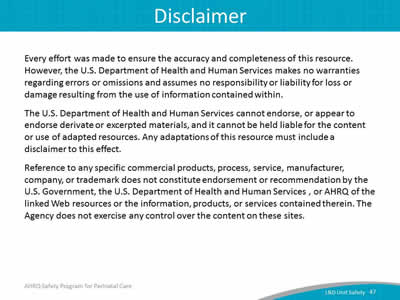Labor and Delivery Unit Safety: Facilitator Guide
AHRQ Safety Program for Perinatal Care
Slide 1: Labor and Delivery Unit Safety
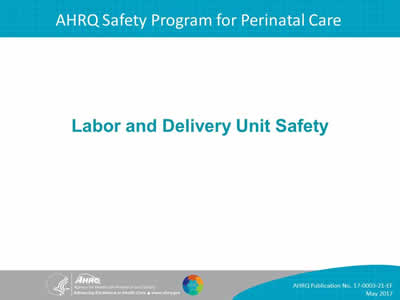
Say:
The “Labor and Delivery Unit Safety” bundle provides information on the key safety elements concerning four specific situations encountered in labor and delivery, and the importance of a comprehensive unit-based safety approach to reduce the potential for maternal and neonatal harms.
Slide 2: Learning Objectives
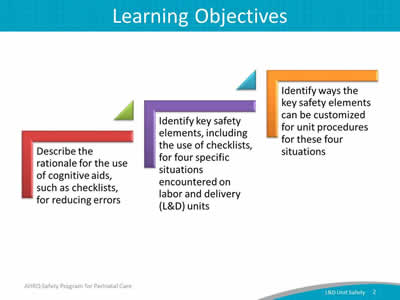
Say:
In this presentation, we will do the following:
- Describe the rationale for the use of checklists for reducing errors.
- Identify the key safety elements for four specific situations encountered on labor and delivery (L&D) units.
- Identify ways the key safety elements can be customized for unit procedures for these four situations.
Slide 3: L&D Unit Safety Tools
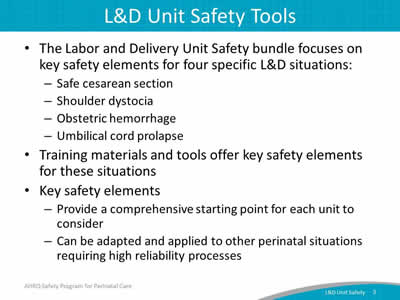
Say:
This bundle in the AHRQ Safety Program for Perinatal Care, or SPPC, focuses on key safety elements for four specific L&D situations:
- Safe cesarean section.
- Shoulder dystocia.
- Obstetric hemorrhage.
- Umbilical cord prolapse.
The training materials and tools for this bundle offer key safety elements for these situations, with a focus on the use of a checklist. These key safety elements provide a starting point for each unit to consider as it establishes processes for ensuring safe care. These key safety elements can also be adapted and applied to other perinatal situations that require high-reliability processes.
Slide 4: Rationale for Use of Checklists

Say:
Care delivery varies greatly based on individual provider training, provider interpretation of evidence, their experience, and their preferences. Checklists help to facilitate safety in high-complexity, high-risk, and high-reliability professions such as aviation, nuclear power plant operations, and naval submarine crews. Hospitals can adopt checklists to ensure the completion of critical procedures and processes within health care settings.
Cognitive psychology classifies tasks as either involving schematic behavior or attentional behavior. Schematic behavior includes tasks performed reflexively or "on auto-pilot," whereas attentional behavior requires active planning or problem solving. The types of failures resulting from these behaviors are different. Errors associated with schematic tasks are labeled "slips" and occur because of lapses in concentration, distractions, or fatigue. Errors associated with failures of attentional behavior are labeled "mistakes" and often occur because of lack of experience or insufficient training. Most errors in health care are slips rather than mistakes. Checklists are cognitive aids that have numerous practical benefits, including reducing slips that occur due to lapses in concentration, distractions, fatigue, or lack of knowledge of evidence-based practices, because checklists decrease reliance on memory for tasks typically performed reflexively or "on auto-pilot." Checklists can also provide confidence that no step will be forgotten.
Slide 5: Role of Checklists
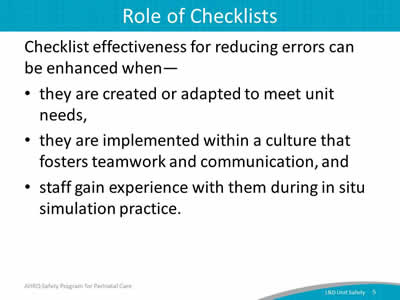
Say:
Simply giving a generic checklist to staff, or posting one on a rapid response cart or kit or on a wall is unlikely to be effective at reducing errors.
Checklist effectiveness for reducing errors can be enhanced when—
- They are created or adapted to meet unit needs.
- They are implemented within a culture that fosters teamwork and communication.
- Staff gain experience with them during in situ simulation practice.
Slide 6: L&D Unit Safety Tools
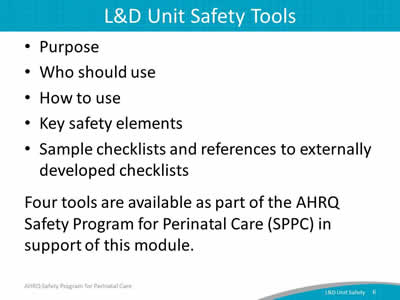
Say:
Each of the four tools in this bundle of the SPPC includes—
- The tool’s purpose.
- Its intended use by nurses, physicians, midwives and other L&D staff responsible for intrapartum care.
- Key safety elements presented within the framework of the Comprehensive Unit-based Safety Program, or CUSP.
- A sample checklist or references or links to available checklists and other cognitive aids are provided for each situation.
The key safety elements, sample checklists, and externally referenced checklists provide a starting point for each unit to consider as examples for establishing safe processes for L&D unit safety.
Units can customize, adapt, and tailor the specific clinical guidance or instructions on the checklist based on unit preferences, best practices, or emerging clinical evidence. The sample checklists provided are examples of how key safety elements can be operationalized in a checklist; they are not provided as an endorsement of a specific clinical approach to management.
Slide 7: SPPC Key Perinatal Safety Elements for L&D Unit Safety
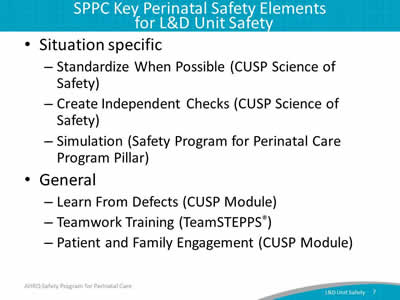
Say:
As in the other customizable bundles available through the SPPC, the key safety elements for L&D unit safety are organized into six overarching principles of patient safety derived from CUSP and the TeamSTEPPS® teamwork and communication system. In this presentation, the six principles are presented by focusing first on situation-specific elements related to these three principles:
- Standardize When Possible.
- Create Independent Checks.
- Simulation.
This will be followed by the discussion of the other three principles that have a more general application across all of the four perinatal situations:
- Learn From Defects.
- Teamwork Training.
- Patient and Family Engagement.
Slide 8: Safe Cesarean Section
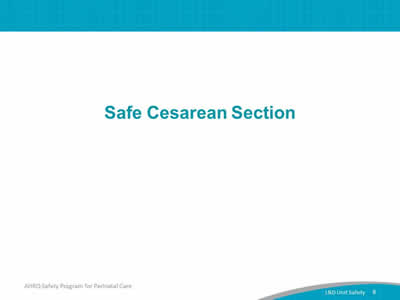
Say:
First, we will highlight some of the key safety elements from the tool for safe cesarean section.
Slide 9: Key Safety Elements: Standardize When Possible
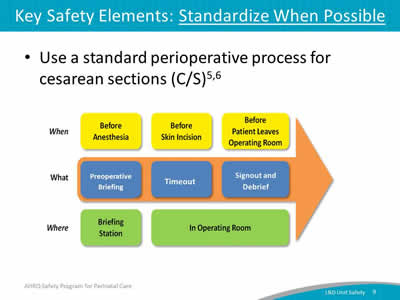
Say:
The first consideration of L&D unit safety for safe cesarean section is to standardize when possible.
This is a core principle from the CUSP Science of Safety module. Standardizing procedures reduces and alleviates duplications of labor and resources, reduces unwarranted variation among providers and staff, and offers a predictable approach that encourages a shared mental model across the unit.
The key safety elements focus on the use of a standard perioperative process that includes—
- Preoperative briefing.
- Timeout.
- Signout.
Studies have found that the use of a standardized perioperative process with these three components reduces surgical mortality and complications. This perioperative process should be the standard approach used for ALL cesarean sections and should include—
- Involving all physicians and staff members engaged in the surgery.
- Knowing which member of the surgical team member is responsible for leading each step of the perioperative process.
- Knowing the defined roles for each staff member involved in the surgery to reduce variability from case to case and create redundancy at critical steps.
- Defining acceptable variations in the perioperative process for emergency cesarean sections.
Slide 10: Key Safety Elements: Standardize When Possible
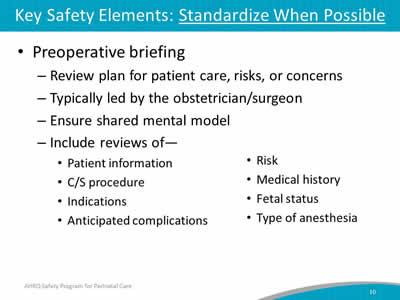
Say:
The preoperative briefing reviews the plan ahead for patient care and the risks or concerns so that everyone has a shared mental model. It includes reviewing patient information, procedure, indications, anticipated complications, risk, medical history, fetal status, and type of anesthesia. The obstetrician/surgeon typically leads the preoperative briefing. It allows him or her to "flatten the hierarchy" in the operating room, and encourage staff to speak up for safety if they see something they don’t think is right.
Slide 11: Key Safety Elements: Standardize When Possible
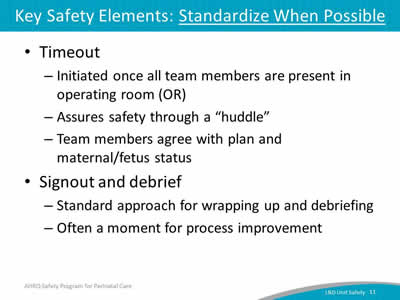
Say:
- The timeout assures safety through a "huddle" or another checkpoint of redundancy for each team member to agree with the plan and maternal and fetal status. The timeout is typically led by the circulating nurse once all staff members are present in the operating room or OR.
- The signout and debrief provides a standard approach for wrapping up and debriefing the case by reviewing what has been done, the patient’s current status, next steps, and what went well, what may have gone better or what might be done in the future, which is often a moment for process improvement. The signout is also typically led by the circulating nurse but may be initiated by anyone on the team.
Slide 12: Key Safety Elements: Create Independent Checks
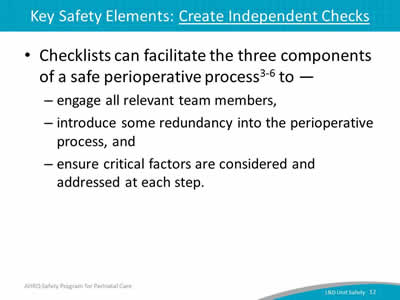
Say:
The second consideration of L&D unit safety for safe cesarean section is to create independent checks.
This is also a core principle from the CUSP Science of Safety module. Independent checks help guarantee the patient receives the highest quality of care possible. Independent checks can include checklists, protocols, and briefings with other staff. L&D unit staff are able to focus on patient care and have confidence that untoward events (change in patient condition, errors in dosing, etc.) will be caught by a check or team alert when it occurs.
- The key safety element is to use a checklist to guide the safe surgery perioperative process.
- Studies have found that checklist tools can facilitate the three components of a safe perioperative process.
Slide 13: Sample Checklist: Cesarean Section
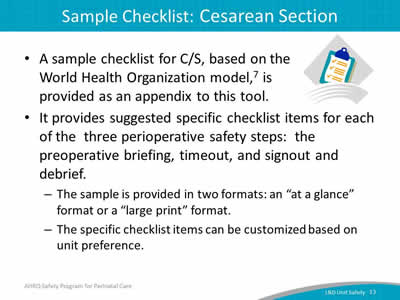
Say:
A sample checklist, provided as an appendix to the tool, helps standardize the perioperative process for cesarean deliveries. Use of a checklist may prevent unnecessary surgical complications and mortality. The checklist serves as a guide for teams by providing key safety-related steps for a preoperative briefing, timeout, and signout and debrief.
Samples of the Safe Cesarean Checklist for Planned/Routine Cesarean Sections are provided in two formats: an "at a glance" format or a "large print" format.
The specific checklist items can be customized based on unit preference.
Slide 14: Key Safety Elements: Simulation
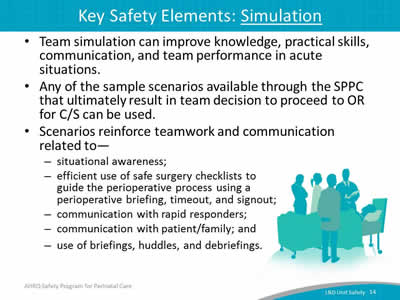
Say:
The next consideration of L&D unit safety for safe cesarean section is simulation.
Team-based in situ simulation can improve knowledge, practical skills, communication, and team performance in acute situations.
Several sample scenarios are available through the SPPC can be used to train teams on the key perinatal safety elements related to safe cesarean section.
Any of the sample scenarios available through the SPPC that ultimately result in a team’s decision to proceed to the OR for cesarean section delivery either emergently or nonemergently can be used.
These scenarios reinforce teamwork and communication related to—
- Situational awareness.
- Efficient use of safe surgery checklists to guide the perioperative process using a perioperative briefing, timeout, and signout.
- Communication with rapid responders.
- Communication with patient/family.
- Use of briefings, huddles, and debriefings.
Slide 15: Shoulder Dystocia
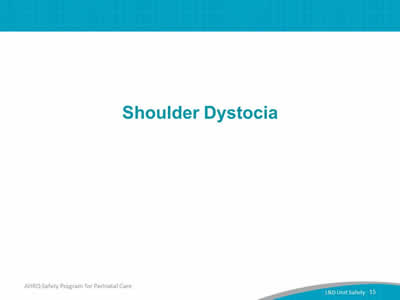
Say:
Now, let’s look at some of the key safety elements from the tool related to care during a delivery complicated by shoulder dystocia.
Slide 16: Key Safety Elements: Standardize When Possible
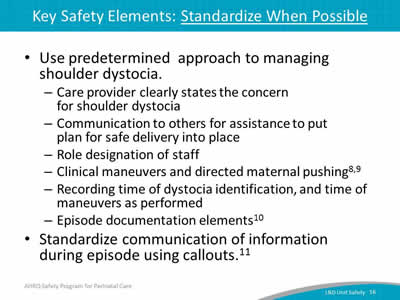
Say:
The first consideration of L&D unit safety for management of shoulder dystocia is to standardize when possible.
The key safety elements focus on the use of an established approach to managing and documenting episodes of shoulder dystocia and standardizing communication during an episode. This approach can include—
- The care provider clearly stating the concern for shoulder dystocia.
- Communication to others for assistance to put plan for safe delivery into place.
- Role designation of staff (e.g. recorder, patient/family communicator).
- Clinical maneuvers and directed maternal pushing.
- Recording the time of dystocia identification, and the time of maneuvers as performed.
- Episode documentation elements.
Standardize communication using call outs—
- To state concern for dystocia.
- For fetal condition.
- As each clinical maneuver is attempted.
- For number of minutes that have passed since diagnosis.
Slide 17: Key Safety Elements: Create Independent Checks
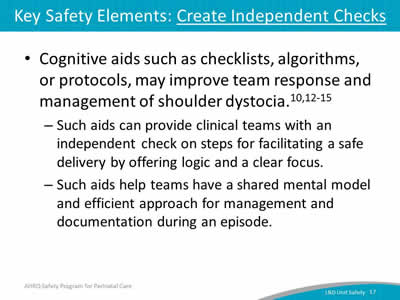
Say:
The next consideration of L&D unit safety for shoulder dystocia management is to create independent checks.
- Cognitive aids such as checklists, algorithms, or protocols may improve clinical team response and management of shoulder dystocia.
- Such aids can provide clinical teams with an independent check on steps for facilitating a safe delivery by offering logic and a clear focus during what can often be a chaotic event.
- Such aids help teams have a shared mental model and efficient approach for management and documentation during an episode.
Slide 18: Sample Checklist: Shoulder Dystocia
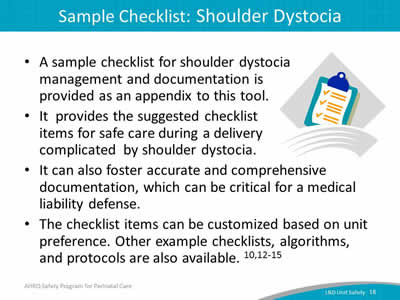
Say:
A sample checklist for shoulder dystocia is provided as an appendix to this tool. It provides suggested checklist items that teams can use for safe care during an episode of shoulder dystocia, and can also foster accurate and comprehensive documentation, which can be critical for a medical liability defense.
- The specific checklist items can be customized based on unit preference.
- Other sample checklists, algorithms, and protocols are also available.
Slide 19: Key Safety Elements: Simulation
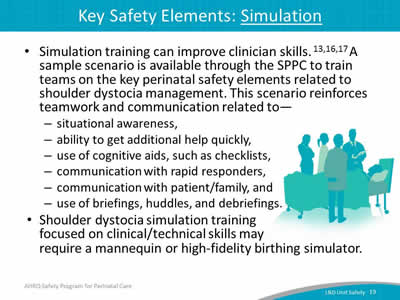
Say:
The next consideration of L&D unit safety for shoulder dystocia management is simulation. Studies have shown that simulation training can improve clinician skills. A sample scenario is available through the SPPC to train teams on the key perinatal safety elements related to shoulder dystocia management. This scenario reinforces teamwork and communication related to—
- Situational awareness.
- Ability to get additional help quickly.
- Use of cognitive aids, such as checklists.
- Communication with rapid responders.
- Communication with patient/family.
- Use of briefings, huddles, and debriefings.
Shoulder dystocia simulation training focused on clinical/technical skills may require a mannequin or high-fidelity birthing simulator.
Slide 20: Obstetric Hemorrhage
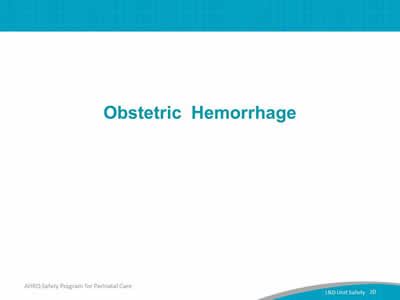
Say:
In this segment we will discuss some of the key safety elements from the tool related to obstetric hemorrhage.
Slide 21: Key Safety Elements: Standardize When Possible
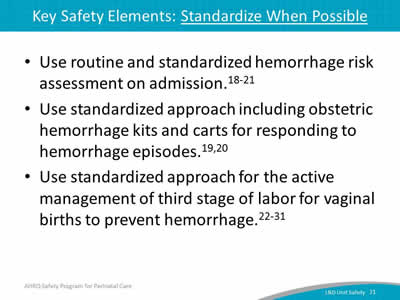
Say:
The first consideration of L&D unit safety for management of obstetric hemorrhage is to standardize when possible.
The key safety elements focus on a hemorrhage response protocol that provides a standardized approach to management and timely treatment intensification for responding to identified obstetric hemorrhages. This approach can include—
- The use of routine and standardized hemorrhage risk assessment on admission.
- Individual risk factors predict some occurrences of obstetric hemorrhage.
- Risk assessments may include the presence of clinical conditions that increase risk of hemorrhage, or patient preferences that may limit the use of blood and blood products in the event of a hemorrhage.
- Risk assessment can then determine the unit’s process for patients based on level of risk, for example different criteria for type and hold, versus type and screen, versus type and cross, criteria for intravenous (IV) access, and need for readily available specialized equipment (e.g., rapid volume infusers, cell saver technology).
- The use of standardized obstetric hemorrhage kits and carts. This allows for rapid access to pharmacologic therapy, such as uterotonics, and the surgical equipment necessary to respond quickly to a hemorrhage.
- The use of a standardized approach for active management of the third stage of labor for vaginal births to prevent hemorrhage.
- However, achieving unitwide agreement on the components of an active management approach may be challenging because of the available evidence about active management, differing values and opinions about the use of active versus expectant management, and patient preferences.
- Consider using CUSP strategies to gain consensus on a standard approach that yields the most standardization while still allowing flexibility for patient preferences and/or where evidence is insufficient and variability in approach is unlikely to increase risk of errors.
Slide 22: Key Safety Elements: Create Independent Checks
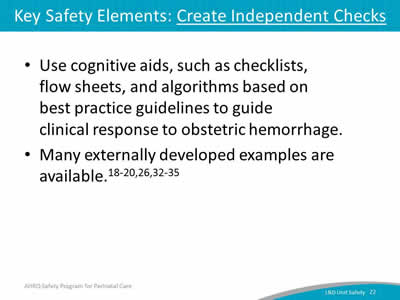
Say:
The next consideration of L&D unit safety for postpartum hemorrhage management is to create independent checks.
- To reiterate, cognitive aids support standardization and a shared mental model.
- Many externally developed examples are available as part of perinatal safety and quality initiatives of states or professional associations.
Slide 23: Key Safety Elements: Create Independent Checks
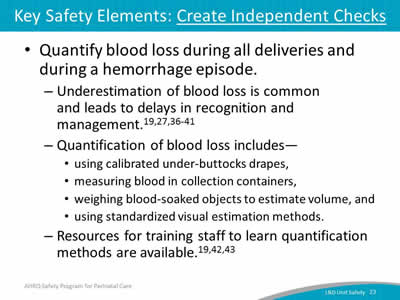
Say:
Another element related to creating independent checks is to quantify blood loss during all deliveries and during a hemorrhage episode.
Nonstandardized, informal, visual estimation methods typically underestimate blood loss, resulting in delayed recognition and management of obstetric hemorrhage.
Methods for quantifying blood loss may vary by type of delivery (vaginal or cesarean) but typically involve quantifying blood loss beginning immediately after birth of the infant, using calibrated under-buttocks drapes, direct measurement of blood in collection containers, weighing blood blood-soaked objects to estimate volume, or using standardized methods of visual estimation.
Resources for training staff to learn quantification methods are available.
Slide 24: Key Safety Elements: Simulation
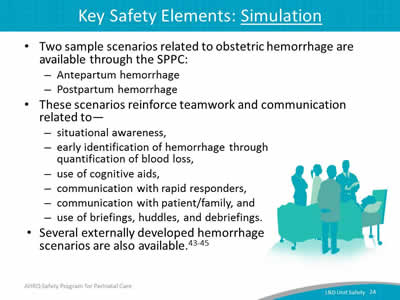
Say:
The next consideration is simulation.
Two sample scenarios, available through SPPC, can be used to train teams on the key perinatal safety elements related to a team approach to obstetric hemorrhage. These scenarios, one for antepartum hemorrhage and one for postpartum hemorrhage, reinforce teamwork and communication related to—
- Situational awareness.
- Early identification of hemorrhage through quantification of blood loss.
- Use of cognitive aids.
- Communication with rapid responders.
- Communication with patient/family.
- Use of briefings, huddles, and debriefings.
Several externally developed scenarios are also available.
Slide 25: Cord Prolapse
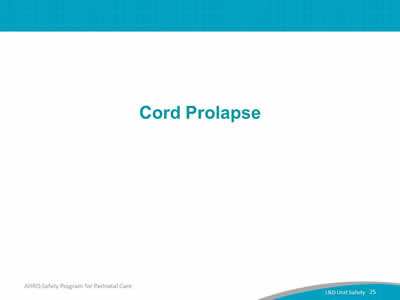
Say:
In this segment, we will discuss some of the key safety elements from the tool related to care during a delivery complicated by cord prolapse.
Slide 26: Key Safety Elements: Standardize When Possible
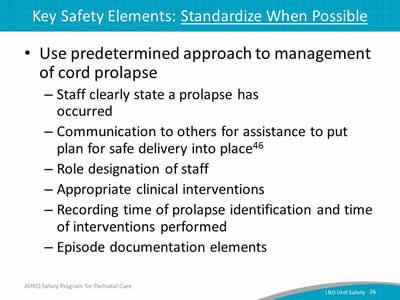
Say:
The first consideration of L&D unit safety for cord prolapse management is to standardize when possible.
The key safety elements focus on a cord prolapse response protocol that uses a unit-approved predetermined approach, and standard communication of information to manage a cord prolapse. This approach can include—
- Staff who identify a possible prolapse and call out the concern.
- Communication to others for assistance to put plan for safe delivery into place.
- Role designation of staff (e.g., recorder, patient/family communicator).
- Appropriate clinical interventions.
- Recording of time of prolapse identification, and time of interventions performed.
- Episode documentation elements.
Slide 27: Key Safety Elements: Create Independent Checks
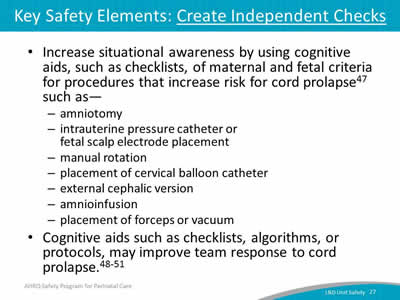
Say:
The next consideration of L&D unit safety for cord prolapse management is to create independent checks.
Staff can increase situational awareness by using cognitive aids, such as checklists, of maternal and fetal criteria for procedures that increase risk for cord prolapse such as—
- Amniotomy.
- Intrauterine pressure catheter or fetal scalp electrode placement.
- Manual rotation.
- Placement of cervical balloon catheter.
- External cephalic version.
- Amnioinfusion.
- Placement of forceps or vacuum.
Cognitive aids such as checklists, algorithms, or protocols, may improve team response to cord prolapse.
Slide 28: Sample Checklist: Cord Prolapse
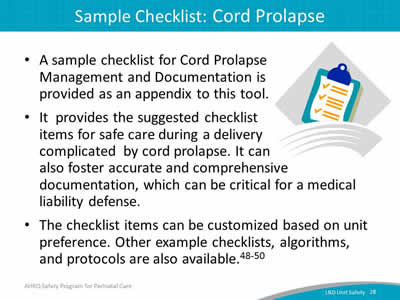
Say:
- A sample cord prolapse management and documentation checklist is provided as an appendix to this tool.
- This sample provides suggested checklist items for safe care during a delivery complicated by cord prolapse. It can also foster accurate and comprehensive documentation, which can be critical for a medical liability defense. Although the steps in the sample checklist are presented in sequential order; this is done to ensure that no steps are missed rather than to dictate a rigid sequence of events. The L&D team should use its clinical judgment and evidence-based practices to determine the order of steps. In practice, steps listed may not occur sequentially.
- The checklist items can be customized based on unit preference. Other example checklists, algorithms, and protocols are also available.
Slide 29: Key Safety Elements: Simulation
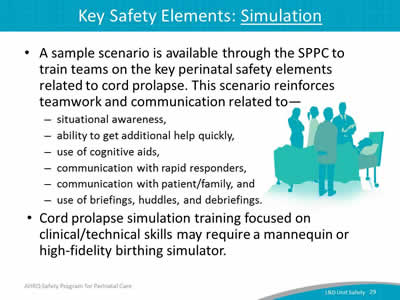
Say:
The next consideration of L&D Unit Safety for cord prolapse management is simulation.
A sample scenario, available through SPPC, can be used to train teams on the key perinatal safety elements related to a team approach to cord prolapse. This scenario reinforces—
- Situational awareness.
- Ability to get additional help quickly.
- Use of cognitive aids.
- Communication with rapid responders.
- Communication with patient/family.
- Use of briefings, huddles, and debriefings.
Cord prolapse simulation training focused on clinical/technical skills may require a mannequin or high-fidelity birthing simulator.
Slide 30: Labor and Delivery Unit Safety
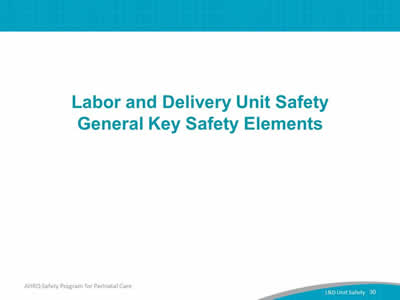
Say:
Now let’s focus on the remaining three key safety elements with more general application included in each of the tools:
- Learn from defects.
- Teamwork training.
- Patient and family engagement.
Slide 31: Key Safety Elements: Learn From Defects
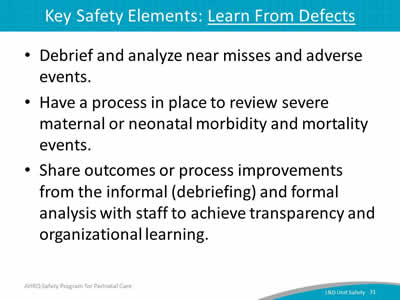
Say:
Key perinatal safety elements around learn from defects include—
- Fostering a culture that supports debriefing by the clinical team immediately after a near miss, an adverse event, or an otherwise complex episode of care.
- A unit can decide its approach to debriefing events based on the seriousness of the event, expertise available, and data monitoring and tracking capabilities.
- Having a process in place to review severe maternal or neonatal morbidity and mortality events.
- A unit can decide its approach but this review might include an existing medical peer review process or review by a perinatal safety or quality committee.
- Share outcomes or process improvements from informal debriefings and formal analyses with staff to achieve transparency and organizational learning.
Slide 32: Key Safety Elements: Teamwork Training
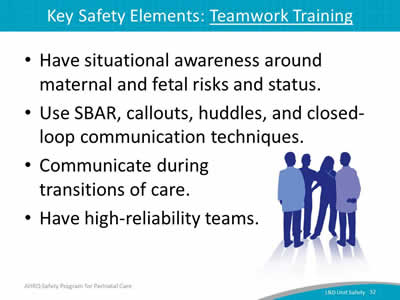
Say:
The fifth consideration is teamwork training.
This aspect of perinatal safety calls for L&D units to foster a culture of teamwork and communication to promote effective teamwork. TeamSTEPPS® teamwork training offers several useful communication techniques.
These include—
- Having situational awareness about maternal and fetal risks and status. This includes staff alertness for issues that raise maternal or fetal risk and for early signs of fetal or maternal distress, and knowing the plan for a timely response to prevent further deterioration.
- Using SBAR (Situation, Background, Assessment, and Recommendation), callouts, huddles, and closed-loop communication among team members. These are useful for communicating a sense of urgency when requesting help responding to sudden changes in maternal or fetal status, and for briefing new care team members as they arrive to assist, and give or receive orders.
- Communicating during transitions of care helps to assure a shared mental model of the plan of care and perceived risks between shifts, between units, or between individuals within the same unit.
- Having high-reliability teams means that anyone can sound an alarm, request help, or challenge the status quo; hierarchy is minimized; and communication is continuous, valued, and expected.
Slide 33: Key Safety Elements: Patient and Family Engagement
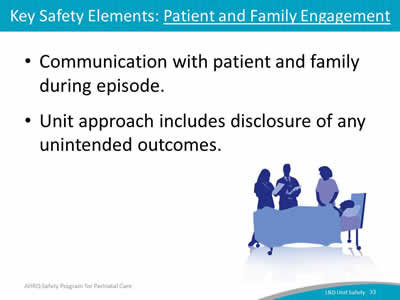
Say:
The final consideration is patient and family engagement.
The key safety elements are as follows:
- Communicating and educating patients and families around the clinical processes involved during episodes to ensure a shared mental model with the patient and family as well as the clinical team. This may include assigning a staff member to communicate with the family during the response, and providing ongoing reassurance.
- Likewise, a unit must be ready to disclose any unintended outcomes. Unit-established process for disclosing unintended outcomes may include the following:
- Prompt, compassionate, and honest communication with the patient and family.
- Investigation.
- Ongoing communication with the patient and family.
- Apology and remediation.
- System and process improvement.
- Measurement and evaluation.
- Education and training.
Slide 34: Customizing the Key Elements & Checklists
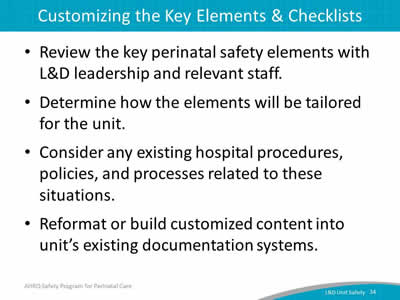
Say:
Key perinatal safety elements, sample checklists, and externally available examples can be used to develop the unit’s specific approaches to safe cesarean section, shoulder dystocia, obstetric hemorrhage, and cord prolapse.
- Review the key safety elements with L&D leadership and relevant staff
- Determine how the elements will be customized for the unit.
- Consider any existing hospital procedures, policies, processes related to these four situations.
- Review the sample checklists and modify or build content to fit with existing documentation systems.
Slide 35: Unit Next Steps
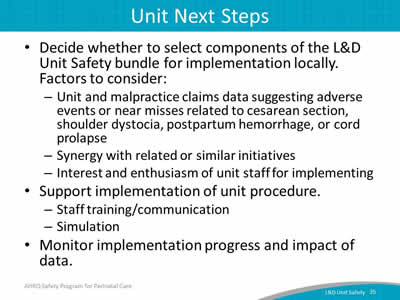
Say:
The next steps are to—
- Decide whether to select components of the L&D Unit Safety bundle for implementation locally. Factors to consider—
- Unit and malpractice claims data suggesting adverse events or near misses related to cesarean section, shoulder dystocia, postpartum hemorrhage, or cord prolapse.
- Synergy with related or similar initiatives.
- Interest and enthusiasm of unit staff for implementing.
- Support implementation of unit procedure with—
- Staff training and communication.
- Use of simulation.
- Monitor implementation progress and impact of data.
Slide 36: Tips for Implementation Success
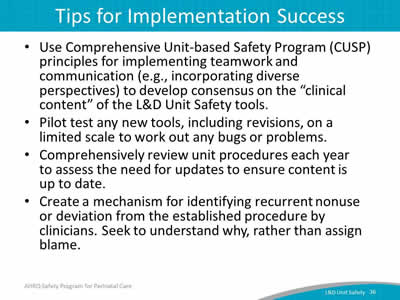
Say:
Here are some tips for implementing tools successfully:
- Use CUSP principles for implementing teamwork and communication (e.g., incorporating diverse perspectives) to develop consensus on the "clinical content" of the L&D Unit Safety tools.
- Pilot test any new procedures to work out any bugs or problems.
- Comprehensively review unit procedures each year to assess the need for updates to ensure content is up to date.
- Create a mechanism for identifying recurrent nonuse or deviation from the established procedure by clinicians. Seek to understand why, rather than assign blame.
Slide 37: References
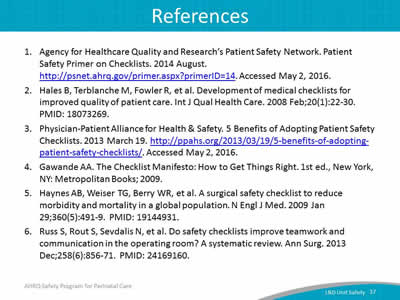
Slide 38: References
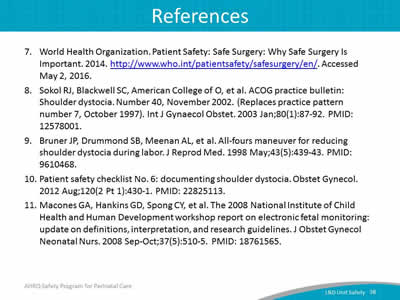
Slide 39: References
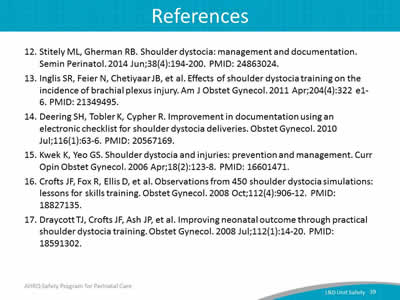
Slide 40: References
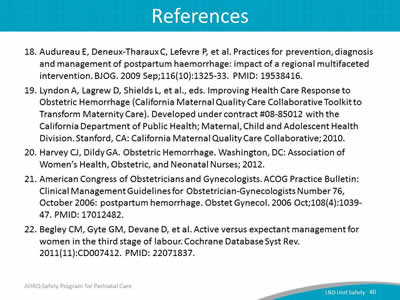
Slide 41: References
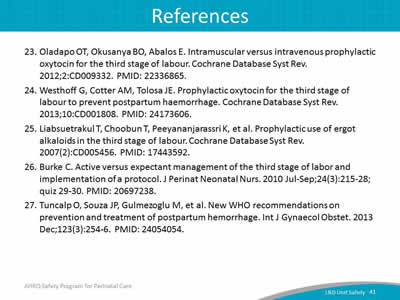
Slide 42: References
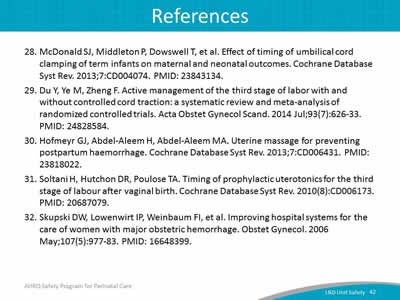
Slide 43: References
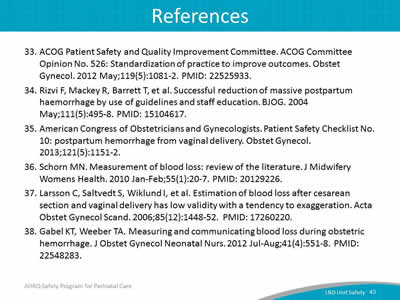
Slide 44: References
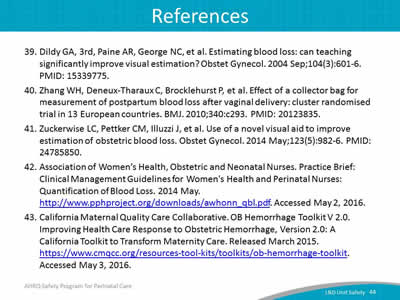
Slide 45: References
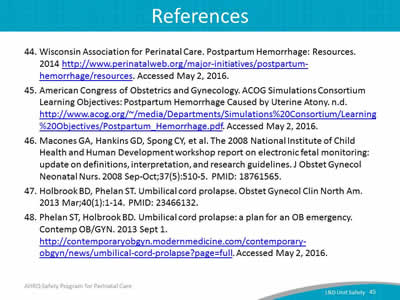
Slide 46: References
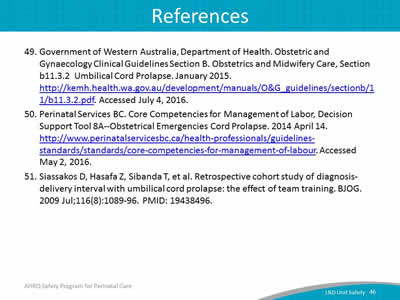
Slide 47: Disclaimer
